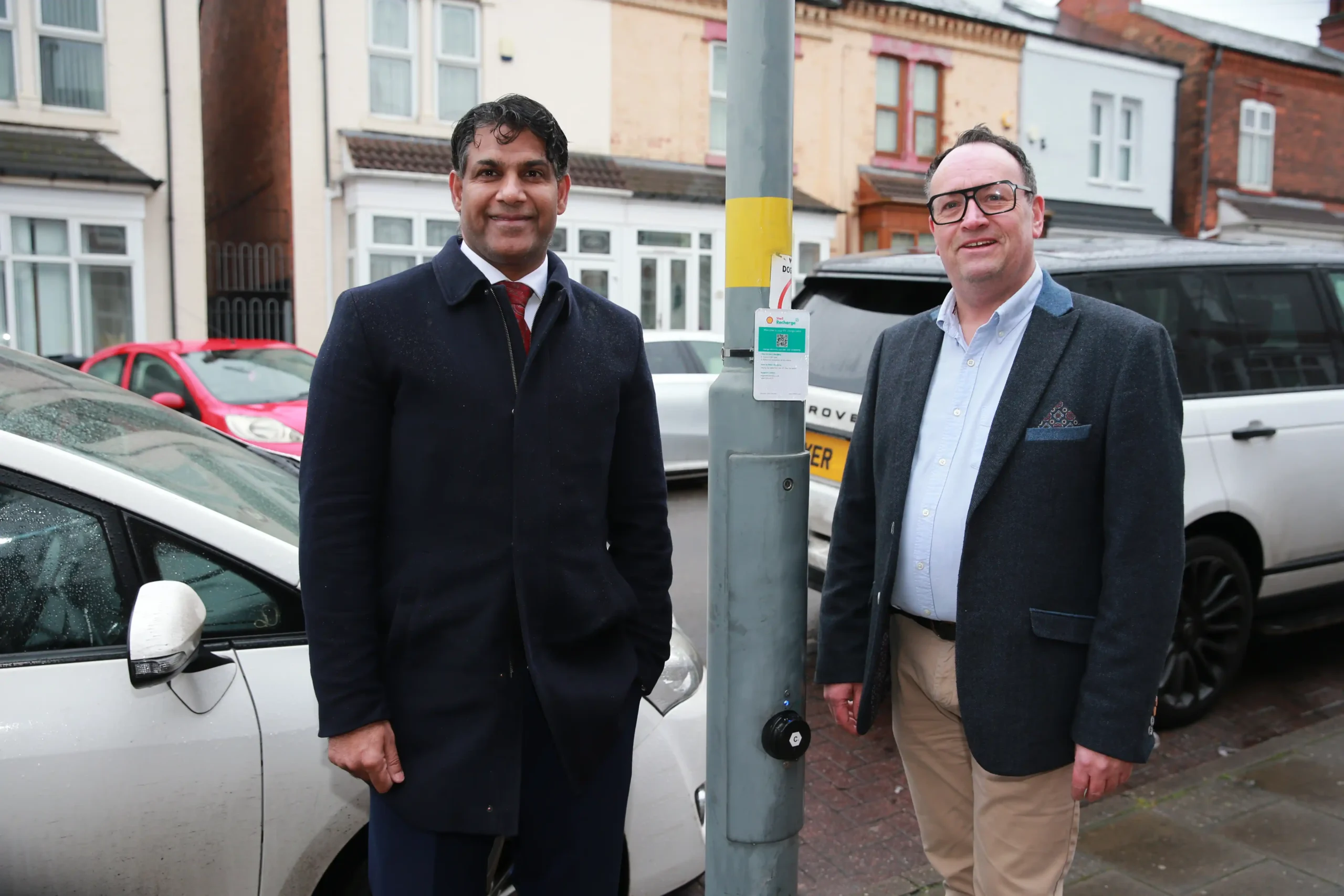Expansion of public charging infrastructure will help increase access to overnight charging for residents without off-street parking.
London & Birmingham, UK 6th February 2025 – Birmingham City Council today announced the launch of a major new project to expand the city’s electric vehicle (EV) charging network. In partnership with Ubitricity, the UK’s largest charge point operator, the Council is carrying out a pilot deployment of 560 lamppost EV charge points across residential areas of the city where access to private off-street parking is limited or unavailable.
This rollout represents the first project of its kind in the UK’s second-largest city and is expected to set a new standard for on-street EV charging. The project is being delivered in response to data showing that most electric cars are kept at homes without access to a private driveway. Not having access to overnight charging ‘on your doorstep’ can act as a deterrent to EV ownership [1]. This initiative, part of Birmingham’s wider Electric Vehicle Charging Strategy, is aimed at improving access to EV charging infrastructure.
ubitricity, a wholly owned subsidiary of Shell and the UK’s largest EV charge point operator, will supply, install, own, operate, and maintain the new charge points on behalf of Birmingham City Council. This partnership is expected to accelerate the transition to electric vehicles by providing an accessible, convenient charging solution for those who rely on on-street parking.
The 560 charge points will be installed in lampposts on 82 streets across the city, with each point taking less than an hour to install. The installation process is designed to minimise disruption and meets the Council’s key requirement to avoid street clutter, while strategically placing charge points based on resident demand and grid connection availability.
Deployed using Office of Zero Emission Vehicles (OZEV) On-Street Residential Chargepoint Scheme (ORCS) funding, the first 300 of these charge points have already been installed, and the remaining 260 will be installed before the end of Spring 2025.
Transport accounts for around a third of CO2 emissions in Birmingham [2]. In June 2019, Birmingham City Council declared a climate emergency and set an ambition for the city to become net-zero by 2030 or as soon as possible after that date as a ‘just transition’ allows. To reduce, and eventually eliminate emissions from transport, it is necessary to shift remaining vehicles to ultra-low and zero-emission vehicles, including electric vehicles (EVs). To enable the uptake of electric vehicles, a comprehensive public EV charging network across Birmingham is needed. As part of this effort, the city is focused on ensuring that EV charging infrastructure is accessible to all residents, including those who use taxis, car clubs, and commercial fleets, as well as private individuals without off-street parking.
The pilot rollout respects the city’s broader commitment to the Council’s Birmingham Transport Plan 2031, and supports the objectives of the Brum Breathes Clean Air Strategy and the Route to Net Zero initiative. These initiatives aim to make walking, cycling, and public transport the preferred choice for getting around, whilst ensuring that remaining private vehicle use is enabled through access to clean, zero-emissions charging infrastructure.
Councillor Majid Mahmood, Cabinet Member for Environment and Transport at Birmingham City Council, emphasised the importance of this initiative in supporting the city’s long-term environmental goals. He stated: “While our focus as a council is on delivering the Birmingham Transport Plan and encouraging people to swap private vehicles for public transport, we also want to ensure that, for those who require use of a car, we have the infrastructure in place to facilitate use of low or zero-emission vehicles.”
Stuart Wilson, UK Managing Director of ubitricity, said: “ubitricity is delighted to be supporting Birmingham City Council as they begin this journey to create one of the largest public EV charging networks outside London, encouraging the transition to electric vehicles, and helping to create a cleaner and healthier, environment for the people of Birmingham.”
ubitricity installed 301 charge points between 15th October and 24th December. As one of the quickest mass rollouts ubitricity has headed, they put the accelerated installation down to close collaboration with the council, with the city’s wide-ranging commitment to EV infrastructure paving the way for other cities to follow suit.
For more information about the City-wide Electric Vehicle Charging Strategy, visit Birmingham City Council’s website.
ENDS
[1] Public electric vehicle charging infrastructure: drivers without access to off-street parking – GOV.UK
[2] City-wide Electric Vehicle Charging Strategy_2021_Birmingham City Council.pdf

Press Contact
Eleanor Bickerton
Marketing & Communications Lead
High resolution photos of ubitricity charge points can be found in our download section.
About ubitricity
ubitricity is a leading provider and operator of public EV charging. Focusing on creating user-oriented charging networks, ubitricity offers AC lamppost, AC fast and DC rapid charging stations. The company operates more than 10,000 charging points within the Shell Recharge network, including the UK’s largest charging network. EV Drivers in Germany, France and the Netherlands are also charging conveniently at an increasing number of ubitricity-operated charge points. ubitricity is a wholly owned subsidiary of the Shell Group. www.ubitricity.com
Cautionary note
The companies in which Shell plc directly and indirectly owns investments are separate legal entities. In this press release “Shell”, “Shell Group” and “Group” are sometimes used for convenience where references are made to Shell plc and its subsidiaries in general. Likewise, the words “we”, “us” and “our” are also used to refer to Shell plc and its subsidiaries in general or to those who work for them. These terms are also used where no useful purpose is served by identifying the particular entity or entities. ‘‘Subsidiaries’’, “Shell subsidiaries” and “Shell companies” as used in this press release refer to entities over which Shell plc either directly or indirectly has control. The term “joint venture”, “joint operations”, “joint arrangements”, and “associates” may also be used to refer to a commercial arrangement in which Shell has a direct or indirect ownership interest with one or more parties. The term “Shell interest” is used for convenience to indicate the direct and/or indirect ownership interest held by Shell in an entity or unincorporated joint arrangement, after exclusion of all third-party interest.
Forward-Looking Statements
This press release contains forward-looking statements (within the meaning of the U.S. Private Securities Litigation Reform Act of 1995) concerning the financial condition, results of operations and businesses of Shell. All statements other than statements of historical fact are, or may be deemed to be, forward-looking statements. Forward-looking statements are statements of future expectations that are based on management’s current expectations and assumptions and involve known and unknown risks and uncertainties that could cause actual results, performance or events to differ materially from those expressed or implied in these statements. Forward-looking statements include, among other things, statements concerning the potential exposure of Shell to market risks and statements expressing management’s expectations, beliefs, estimates, forecasts, projections and assumptions. These forward-looking statements are identified by their use of terms and phrases such as “aim”; “ambition”; ‘‘anticipate’’; ‘‘believe’’; “commit”; “commitment”; ‘‘could’’; ‘‘estimate’’; ‘‘expect’’; ‘‘goals’’; ‘‘intend’’; ‘‘may’’; “milestones”; ‘‘objectives’’; ‘‘outlook’’; ‘‘plan’’; ‘‘probably’’; ‘‘project’’; ‘‘risks’’; “schedule”; ‘‘seek’’; ‘‘should’’; ‘‘target’’; ‘‘will’’; “would” and similar terms and phrases. There are a number of factors that could affect the future operations of Shell and could cause those results to differ materially from those expressed in the forward-looking statements included in this press release, including (without limitation): (a) price fluctuations in crude oil and natural gas; (b) changes in demand for Shell’s products; (c) currency fluctuations; (d) drilling and production results; (e) reserves estimates; (f) loss of market share and industry competition; (g) environmental and physical risks; (h) risks associated with the identification of suitable potential acquisition properties and targets, and successful negotiation and completion of such transactions; (i) the risk of doing business in developing countries and countries subject to international sanctions; (j) legislative, judicial, fiscal and regulatory developments including regulatory measures addressing climate change; (k) economic and financial market conditions in various countries and regions; (l) political risks, including the risks of expropriation and renegotiation of the terms of contracts with governmental entities, delays or advancements in the approval of projects and delays in the reimbursement for shared costs; (m) risks associated with the impact of pandemics, such as the COVID-19 (coronavirus) outbreak, regional conflicts, such as the Russia–Ukraine war, and a significant cybersecurity breach; and (n) changes in trading conditions. No assurance is provided that future dividend payments will match or exceed previous dividend payments. All forward-looking statements contained in this press release are expressly qualified in their entirety by the cautionary statements contained or referred to in this section. Readers should not place undue reliance on forward-looking statements. Additional risk factors that may affect future results are contained in Shell plc’s Form 20-F for the year ended December 31, 2023 (available at www.shell.com/investors/news-and-filings/sec-filings.html and www.sec.gov). These risk factors also expressly qualify all forward-looking statements contained in this press release and should be considered by the reader. Each forward-looking statement speaks only as of the date of this press release, 17th October 2024. Neither Shell plc nor any of its subsidiaries undertake any obligation to publicly update or revise any forward-looking statement as a result of new information, future events or other information. In light of these risks, results could differ materially from those stated, implied or inferred from the forward-looking statements contained in this press release.
Shell’s net carbon intensity
Also, in this press release we may refer to Shell’s “Net Carbon Intensity” (NCI), which includes Shell’s carbon emissions from the production of our energy products, our suppliers’ carbon emissions in supplying energy for that production and our customers’ carbon emissions associated with their use of the energy products we sell. Shell’s NCI also includes the emissions associated with the production and use of energy products produced by others which Shell purchases for resale. Shell only controls its own emissions. The use of the terms Shell’s “Net Carbon Intensity” or NCI are for convenience only and not intended to suggest these emissions are those of Shell plc or its subsidiaries.
Shell’s net-Zero Emissions Target
Shell’s operating plan, outlook and budgets are forecasted for a ten-year period and are updated every year. They reflect the current economic environment and what we can reasonably expect to see over the next ten years. Accordingly, they reflect our Scope 1, Scope 2 and NCI targets over the next ten years. However, Shell’s operating plans cannot reflect our 2050 net-zero emissions target, as this target is currently outside our planning period. In the future, as society moves towards net-zero emissions, we expect Shell’s operating plans to reflect this movement. However, if society is not net zero in 2050, as of today, there would be significant risk that Shell may not meet this target.
Forward Looking Non-GAAP measures
This press release may contain certain forward-looking non-GAAP measures such as cash capital expenditure and divestments. We are unable to provide a reconciliation of these forward-looking non-GAAP measures to the most comparable GAAP financial measures because certain information needed to reconcile those non-GAAP measures to the most comparable GAAP financial measures is dependent on future events some of which are outside the control of Shell, such as oil and gas prices, interest rates and exchange rates. Moreover, estimating such GAAP measures with the required precision necessary to provide a meaningful reconciliation is extremely difficult and could not be accomplished without unreasonable effort. Non-GAAP measures in respect of future periods which cannot be reconciled to the most comparable GAAP financial measure are calculated in a manner which is consistent with the accounting policies applied in Shell plc’s consolidated financial statements.
The contents of websites referred to in this press release do not form part of this press release.
We may have used certain terms, such as resources, in this press release that the United States Securities and Exchange Commission (SEC) strictly prohibits us from including in our filings with the SEC. Investors are urged to consider closely the disclosure in our Form 20-F, File No 1-32575, available on the SEC website www.sec.gov.
